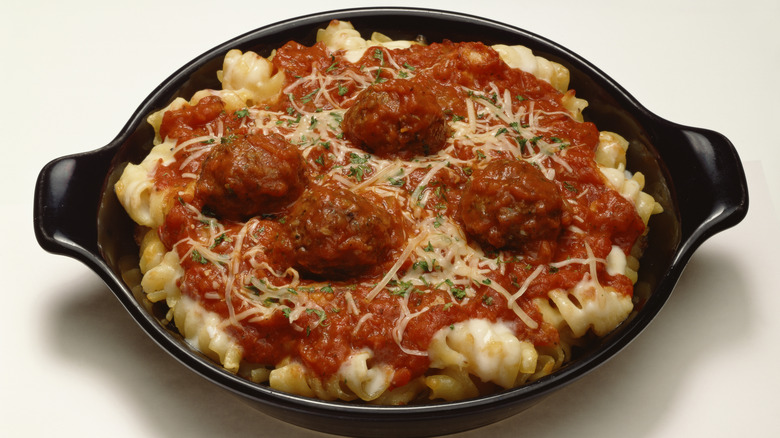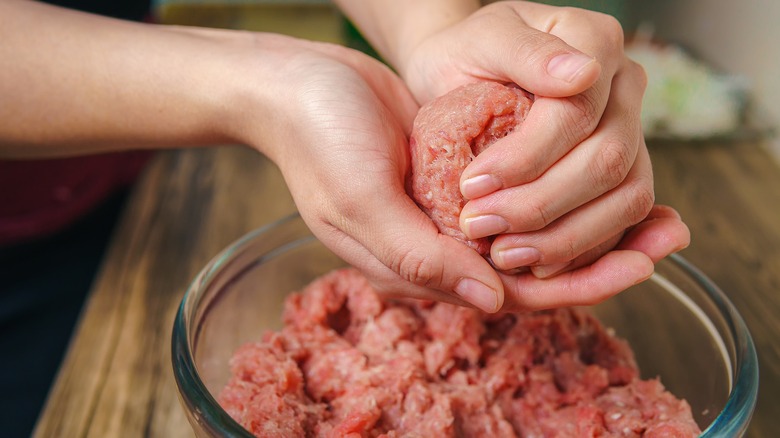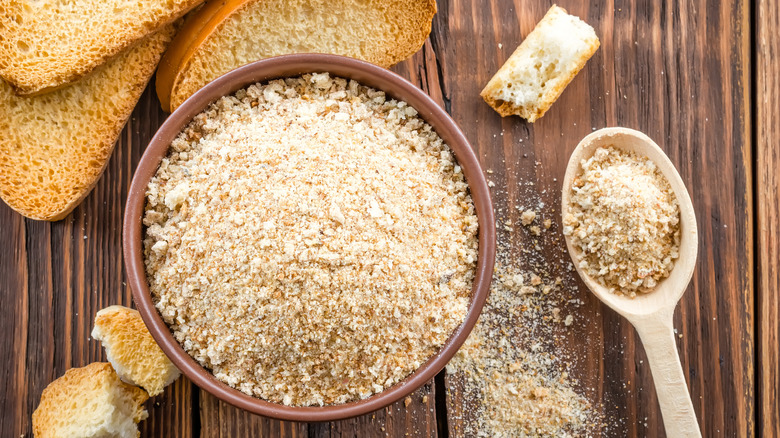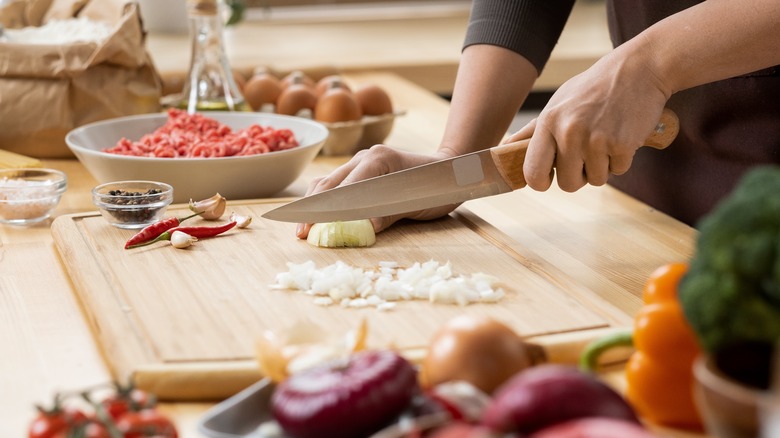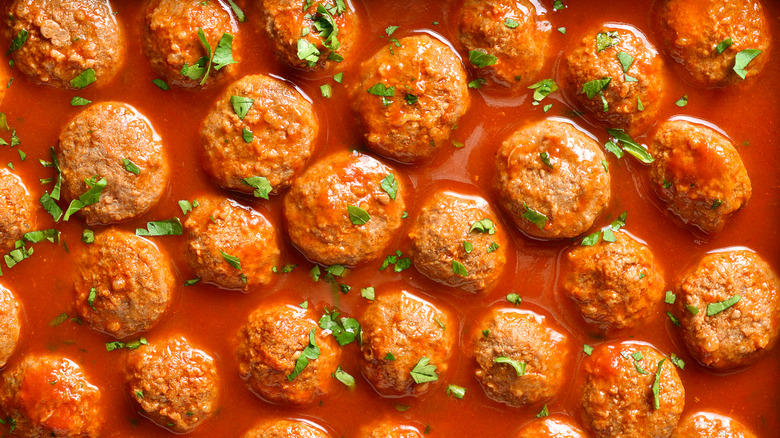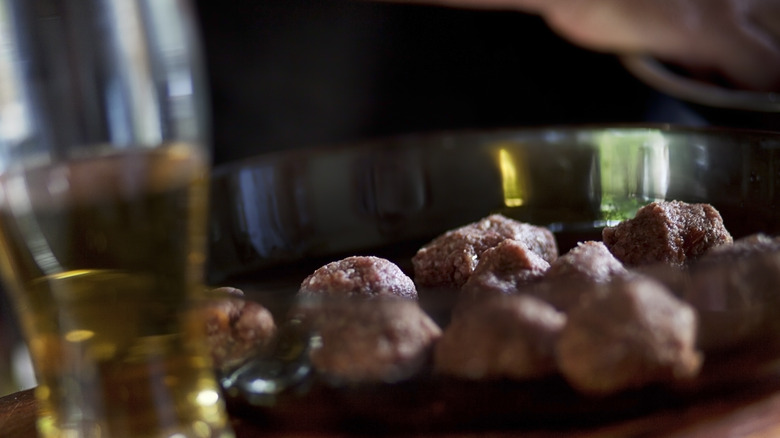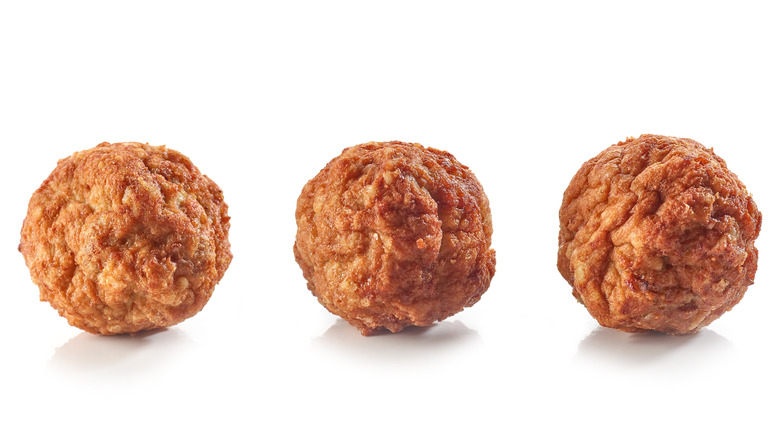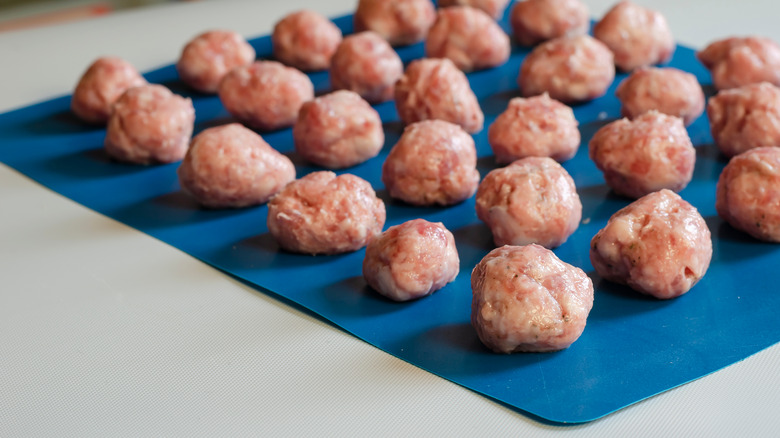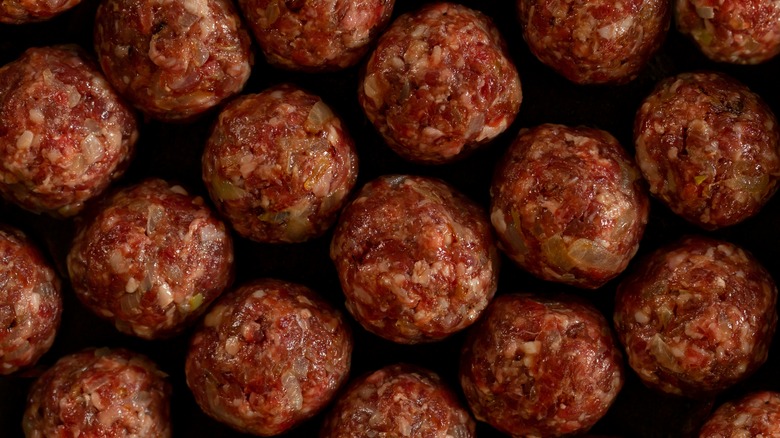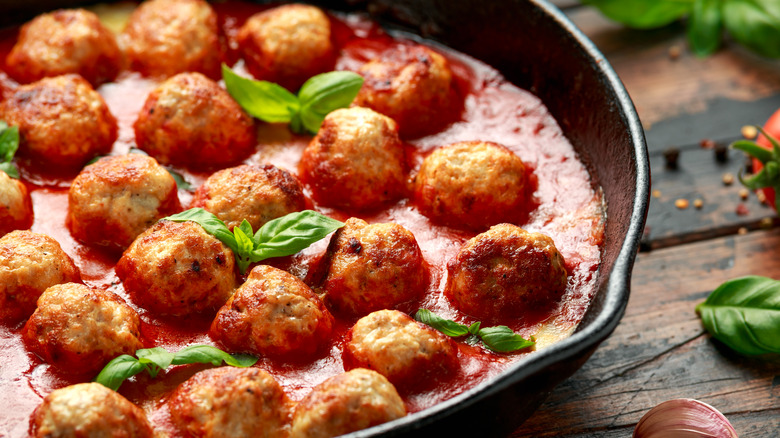Mistakes Everyone Makes When Cooking Meatballs
Meatballs are one of those rare foods that almost everyone likes. Besides being tasty and relatively inexpensive to make (most are made of affordable grocery staples), they're just so much fun to eat and look at. Even the big ones are cute. And the fact that they appear in cuisines around the world, from classic Italian-American spaghetti and meatballs to gently-spiced Swedish meatballs, to hearty Chinese lion's head meatballs, speaks to their near-universal appeal.
But while meatballs recipes are fundamentally simple, this doesn't mean that they're always easy to make. Frustrated home cooks often find themselves with rubbery or mushy meatballs, ones that disintegrate as soon as they hit the pan, or sticky raw meatballs that refuse to let go of your hands no matter what you do.
It might seem hopeless at first, but never fear If you've encountered any of these problems, don't worry, as you're far from alone. And luckily, none of these problems require rocket science to correct. With a bit of care and perhaps some extra time, you can be creating amazing meatballs in short order. Here are some common mistakes everyone makes while cooking meatballs and simple ways to fix them.
Using the wrong type of meat
Many home cooks think of meatballs as a tasty way to stretch a relatively small quantity of meat and thus think of them as a budget dish. Of course, there's absolutely nothing wrong with this. But while meatballs can be delicious when crafted with inexpensive meats, the type you choose still matters. Ideally, you want your finished meatballs to be not only flavorful but moist and tender without being mushy. To achieve this, it's critical to start with the right proportion of meat to fat.
You might be wondering why meatballs need fat if they're also going to include breadcrumbs and eggs, which have their own fat. The truth is much of meat's flavor is in the fat, which also keeps meatballs juicy and moist as it renders. But of course, you don't want to bite down on big chunks of grease when you're enjoying meatballs. When it comes to meatballs, the optimum balance is 70% meat to 30% fat. It's fairly easy to find ground beef with roughly these proportions, but another easy way to achieve this balance is to combine equal parts ground pork (which is inherently fatty) and lean ground beef.
Adding too much filler
Most meatball recipes call for a bit of starchy filler, such as dry breadcrumbs, oatmeal, or soaked bread, which is meant to keep the meatballs tender, hold everything together, and help add bulk. But as in all areas of cooking, balance here is key. Too little of this binder and your meatballs may turn out dry. Yet, add too much and your meatballs may become mushy and could even fall apart.
To pass on this common mistake, avoid the temptation to add extra filler to stretch out your meat supply. That's because the resulting meatballs won't be very satisfying, given that they'll lack some of that meaty flavor. In addition, if you're using a recipe from a trusted source, follow it closely. If it's been professionally tested, there's a good chance the right proportion of bread to meat has already been correctly calculated for you.
Be prepared to get out your scale, too. If the recipe lists amounts of bread or crumbs by weight follow its lead and weigh your filler rather than measuring it by volume with a measuring cup. This will make a big difference since brands of bread crumbs vary in size and composition, which will affect less accurate measuring methods.
Overdoing the eggs
Eggs are another common ingredient in meatball recipes. Because they're so rich and flavorful on their own, many cooks assume that the role of eggs is to lend fat, flavor, and moisture to the finished meatballs. But while eggs do contribute moisture to the initial meatball mixture, most of this will evaporate by the time the meatballs are cooked. Most meatball recipes depend on other ingredients, such as herbs, cheese, and the meat itself for flavor.
Instead, eggs serve a more prosaic function: to help hold everything together. As the eggs cook, their proteins coagulate and solidify, binding all the other ingredients they contact. In effect, they act as a form of edible glue.
Because the role of eggs in meatballs is primarily structural, the amount of eggs you use does matter. You want enough to keep the mixture stable and easy to handle, but too many will make the mixture overly soft. Excess eggs will also make meatballs tough and spongy, rather than toothsome and tender. A good rule of thumb is to add one egg per pound of meat.
Adding too many veggies
For many cooks, one of the most satisfying parts of making meatballs is customizing them with the flavorings of their choice. Meatballs can include anything from herbs and spices to cheese, chopped veggies, and more. Creative cooks know how to take a basic meatball recipe and turn it into something original and surprising with just a few ingredient switches.
But while meatballs invite culinary creativity and offer plenty of opportunities to create new flavor combos that are truly your own, stay mindful of the delicate structural balance needed to keep meatballs intact. For instance, finely chopped vegetables such as mushrooms and onions can contribute a lot of flavor and a nice bit of texture to meatballs, but adding too many of these can throw the texture and structure of your finished meatballs off. The same can happen in your pieces are too large.
With either of these mistakes, the binders that hold your meatballs together (typically bread and eggs) won't be able to stick to and thus bind large quantities of veggies. You may end up with meatballs that are oddly textured or, worse, refuse to hold together at all.
Under-seasoning your meatballs
It's tempting to think of meatballs as miniature relatives of hamburgers. But while both are yummy round treats made with ground meat, their culinary roles are distinct. Burgers, especially high-end ones, are meant to showcase the pure flavor of meat, while meatballs are intended to be self-contained flavor bombs. So while many burger mavens strongly feel that their patties require little more than salt and pepper to be perfect, a good meatball needs to make a strong flavor statement.
First, meatballs need salt. Assuming the meat has arrived without any seasoning, you'll need about one teaspoon per pound of meat. Don't stint on other seasonings, either. Choose herbs, spices, and other ingredients that will complement whatever sauce or other preparation you're serving them with. While you're at it, don't limit yourself to tried-and-true Italian-style meatballs, tasty as they are. You can easily experiment with other flavor profiles, such as Middle Eastern-inspired meatballs that are seasoned with spices such as tart sumac, warm cinnamon, Aleppo pepper, and coriander. Or try crafting some Japanese-style meatballs flavored with ginger and sake. Whatever you try, this is the time to go big or go home. Ultimately, there's no excuse for a meatball to be boring.
Overmixing the meatball mixture
Much of the angst home cooks experience when making meatballs has to do with getting the darned things to hold together. It's common to encounter meatball mixtures that are too soft, sticky, or crumbly to shape. Or you might have meatballs that behave fine until you start cooking or put them into the sauce — at which point they inexplicably decide to dissolve. It's not fun. It's also the reason some cooks go a bit crazy when mixing their meatballs, vigorously stirring or kneading the mixture, then rolling it into tight spheres in hopes of creating meatballs that will hold together when cooked.
These strategies, unfortunately, are serious mistakes because they work a bit too well. Yes, put your muscles to work and your meatballs will be structurally sound, but all that mixing and pressing will make them dense, tough, and rubbery. To obtain tender meatballs, you should handle the mixture as little and as delicately as possible. When mixing the meat and other ingredients, use your hands instead of a spoon and when shaping and cooking the meatballs, use a delicate touch and avoid the temptation to fiddle with each one. After all, no one will notice or care if your meatballs are not quite spherical. However, they will notice if they chew like Super Balls.
Shaping your meatballs right after mixing
While nobody really thinks of meatballs as a fast dish to make, for many cooks, this sort of recipe falls comfortably within the range of doable weeknight meals. An experienced cook can easily mix the ingredients, shape the meatballs, sear them, then simmer them in a sauce after work. If it all falls into place, you can have them on the table in time for dinner. But while this works for some home chefs, a few extra steps and a bit more time can pay big dividends when it comes to flavor and texture.
A common challenge when making meatballs is how to handle the meatball mixture, which is often soft and sticky. But struggling to get a freshly-made meatball mixture to behave can result in overmixing and thus tough meatballs. A good solution to this is to chill the mixture before shaping it. A rest of 20 minutes to an hour in the refrigerator will help stabilize the mixture, making it easier to handle without overworking. While this step will naturally add extra prep time, it will ensure better-tasting meatballs and a less stressful meatball-shaping experience for you.
Making your meatballs the wrong size
Meatballs are fun to make and eat in part because they're so versatile. They can serve as everything from a cocktail appetizer to a stand-alone meal. And depending on where and how they're served, meatballs can come in a range of sizes and offer a range of different, but equally appealing, eating experiences. But a common mistake busy cooks make is neglecting to consider the size of their meatballs. This can make a big difference in both the appearance of a dish and how agreeable it is to eat.
The right size for your meatballs will depend on how they're served. Meatballs in a soup, for example, should be small enough to be consumed in a single bite. If they're going to be served with spaghetti, they can be around 2 inches, or the size of a golf ball. If you're using the meatballs for sandwiches or as a main dish, you can make them slightly bigger still.
However, giant meatballs, like those veering towards hamburger size and beyond, are polarizing. While some chefs have created 7-pound stuffed meatballs for special promotions, others wonder what the purpose of such stunts may be. After all, at what point are you just making meatloaf?
Shaping your meatballs with dry hands
A basic reality when it comes to making meatballs is that it gets messy — after all, you're going to be working with a lot of sticky, gooey ingredients and shaping them with your hands. When you do so, you may find the meatball mixture will stick all over you, making it virtually impossible to form it into smooth, even balls. One way to counteract this is to ensure the meatball mixture is cold when you shape it. Done right, it will be firmer and a bit less sticky.
An extra step you can take here is to wet your hands with cold water before shaping the meatballs. Since you'll have to re-wet your hands frequently as you work, it's a good idea to keep a bowl of cold water close by while you work. Alternatively, you can grease your hands with olive oil before shaping your meatballs. Again, you may find you have to re-apply the oil as you work.
Searing meatballs in a deep pot
Making meatballs can be a messy, multi-step process, so it's natural to want to streamline the cooking and cleaning as much as possible. For example, if you're making meatballs that will eventually be simmered in a sauce, it seems smart and efficient to give the meatballs their initial sear in the same pot you plan to cook the sauce in. Why bother using a second pot that will need to be washed up?
But your meatballs will turn out better if you sear them first in a skillet rather than a high-sided pot. For one, this makes them much easier to manipulate and move around. Getting a spatula under an individual meatball in the middle of a deep pot can be a pain. Additionally, the high sides of a stew pot can hold steam in, causing the meatballs to steam or simmer rather than get a good sear — meaning you lose out on that tasty Maillard reaction. So if getting those nice crusty bits on the exterior of your meatballs matters to you, break out that big frying pan — or bake your meatballs on an oiled baking sheet at medium-high heat until browned.
Adding meatballs to your sauce right after searing them
For those of us who love to cook, making meatballs is satisfying because it's such hands-on work. It can be huge fun to smoosh a bunch of tasty things together with your hands, knowing what a delicious meal it will make in a few hours. But the art of making great meatballs involves not just skilled hands-on work, but an understanding of when to stand back and leave them alone. Besides the obvious steps of mixing, shaping, searing, and simmering, truly great meatballs involve another, often-overlooked step: waiting.
Sometimes, you'll need to build multiple waiting periods into your meatball-making schedule. If your meatball mixture isn't cold right after you make it, then it will benefit from a brief rest in the fridge to firm up before you start shaping. And once you've formed your meatballs, you'll reduce the chance of them falling apart if you chill them again before searing. Finally, don't rush to put your meatballs directly in the saucepot right after searing them. Give them time to cool down, which will help ensure they don't fall apart in the sauce.
Boiling meatballs in the sauce
Meatballs have a reputation as an easygoing, rough-and-tumble sort of food. It's the kind of low-maintenance treat that can endure hours in a chafing dish at a buffet or be casually plopped atop a pile of spaghetti for an informal family meal or potluck. But while meatballs don't require much in the way of special care once they're at the table — there's no need to worry about fancy carving or serving techniques, for instance — preparing them requires a light hand at every stage of production. As we've seen, overmixing and overhandling are some of the biggest obstacles to achieving tender meatballs.
If you've taken the care to use the right proportions of binder to meat and mixed and shaped your meatballs with a delicate hand, you're well on the way to meatball nirvana. But when it comes to meatballs, every step counts, so don't let down your guard yet. Once you've seared your meatballs and let them sit a bit to firm up, it's time to warm them in a sauce and bring them to the table.
But even here you'll need to exercise restraint. So, don't be tempted to rush the process by boiling the sauce with the meatballs in it. The meatballs may heat up faster, but they also run the risk of falling apart if they are violently boiled. So be patient and instead, heat them slowly in gently simmering sauce. The results will be well worth it.
